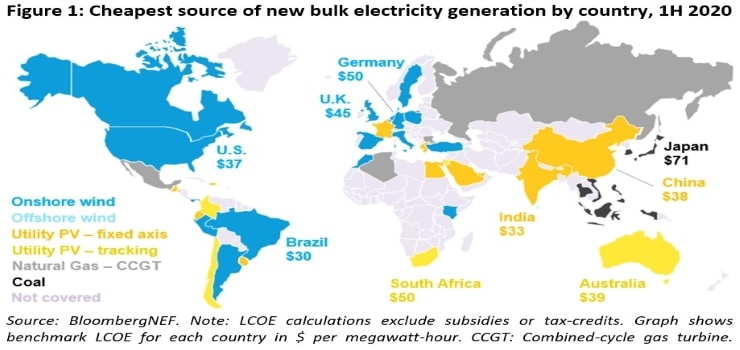Solar Officially Becomes the Cheapest Power Source for Most
Page Contents
Written by qualified solar engineer Aniket. Last updated:
A new Bloomberg NEF study shows that prices for solar power have reached a record low. Solar PV, along with onshore wind are now the cheapest energy sources for two thirds of the world’s population. The interesting fact is that these two thirds of the population consumes 85% of the energy. This means that the majority of the energy consuming population now has solar PV as the cheapest energy source.
The study also shows that the greatest dip in the Levelized Cost of Electricity (LCOE) for utility-scale solar PV and wind came in the second half of 2019. Solar prices in this half of the year fell by 4% to a new low of $50/MWh. This is an indication of how renewables and particularly solar can dominate the coming decades.
Then, Now and Then
Only a decade ago, the average LCOE prices for solar power were 0.360 USD/kWh, translating to $360/MWh – an almost unbelievably high number by today’s standards. By 2017, this number had dropped down 73% to $50/MWh. Less than three years later, solar is at its all-time low.
While the $50/MWh price is an average value of the sample size, some countries, such as India and Brazil, have seen very low prices in the range of $35/MWh. BNEF also believes that globally, prices of $23-29/MWh are achievable in the coming years.

Country-wise cheapest bulk-energy source (Source – BloombergNEF)
But what is more important is not the absolute price of solar, but how it compares with coal. Figures in 2019-20 have been important in that respect. Solar has forever been in a race with coal and oil, and at some point, it was so vastly behind that nobody thought it could catch up. Today, solar has finally taken over coal with regard to pricing.
China, for example, which is the world’s greatest manufacturer and deployer of solar power, has an average LCOE of $35/MWh, and the LCOE of coal in China is at $38/MWh. This is the case in most other countries as well.
The reason for this, according to BNEF report author Tiffen Brandily, is twofold. The first being the rapid advancement in technology. For instance, the efficiency of solar panels has increased from less than 10% to 20% and above in the last 15 years alone. This is remarkable for a technology that started more than 60 years ago but hadn’t seen this level of development for the majority of its time. Secondly, scaling up projects has proved savings in cost for developers, ultimately resulting in lower prices.
These two factors have controlled the growth of the solar sector and will continue to do so. Considering several global economic and political factors, it would be no surprise to see solar emerge as the primary energy source in most, if not all countries.
References
We hope you liked this article. Please rate it or leave us a comment.
Average rating 3.7 / 5. Vote count: 3
No votes so far! Be the first to rate this post.





